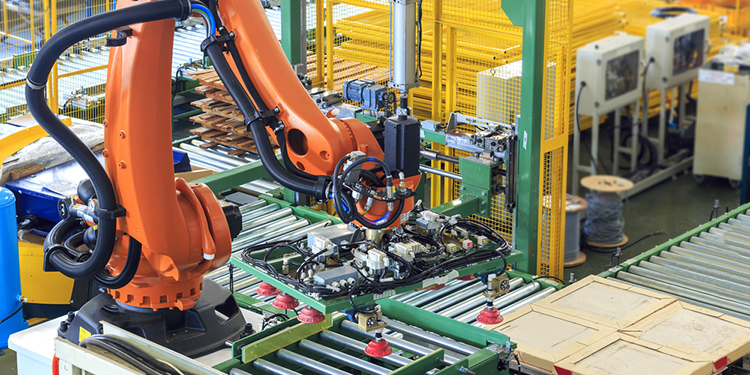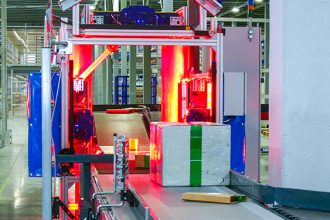10 Tips For Implementing Automated Fulfillment Solutions

To remain competitive and meet customers’ expectations for virtually on-demand product availability and delivery, more and more omni-channel retailers are contemplating automation for some (or all) of processes within their fulfillment operations. Just as there are a variety of opportunities for automation, there are a broad range of considerations to keep in mind during the evaluation of potential equipment and technology solutions. To that end, MHI’s Solutions Community offers “10 Tips For Implementing Fulfillment Warehouse Automation” in a presentation available online. Key takeways include:
- Drivers behind automation decisions
- Ways to reduce a facility’s carbon footprint
- How to increase capacity within existing operations
- Key strategies for managing the growing e-commerce channel
Briefly, here’s an overview of the 10 key considerations when determining the right approach to automating a fulfillment operation:
1. Space. More than just the square footage of a building, a proper space evaluation also requires an analysis of current and predicted inventory volumes, product mixes and assortment, and the potential for expansion of those lines. Other areas to evaluate include the facility’s current configuration. This encompasses the number of dock doors allocated to inbound and outbound shipping, the shape of the building as it relates to workflow processes and paths, current automation equipment and storage solutions, and employee needs — such as accessibility and parking.
2. Energy. A factor for both cost justification and in meeting sustainability mandates, there are a variety of choices that can be made during design and construction to impact energy usage. These include lighting and controls, alternatively powered vehicles, planning for better space utilization, and renewable energy sources like solar and wind power.
3. Software. To ensure the success of the automation installation, regardless of its extent, it is critical to create a joint operations and information technology (IT) team. This reduces the chance of internal conflict during installation and commissioning. Post installation, it’s important to pilot the unused capabilities of the selected software, as it may not be necessary to use all functions in the beginning. Finally, be sure the selected software is both scalable and adaptable to accommodate future operational changes.
4. Picking. One size technology does not fit all picking processes or inventory types. Consider implementing multiple methods that each match the inventory and order profiles in the most optimal way. Those include person-to-goods, goods-to-person, and fully automated solutions that adapt to different inventory characteristics, storage densities, volumes, peaks, and other workload balancing needs.
5. Carbon Footprint. For operations aggressively seeking to reduce their carbon footprint, there are a variety of opportunities to do so during either retrofit or greenfield automation projects. Among them are building design choices (size, equipment, software); energy efficient equipment and lighting; energy efficient heating and cooling options; water usage reduction and conservation systems; opportunities for recycling corrugated and other packaging waste; and adoption of reusable systems, such as plastic trays and totes for internal and external closed-loop inventory handling.
6. Operations Technology. Predictive modeling, advanced analytics, artificial intelligence (AI), Internet of Things (IoT), Big Data — all of these digital, next generation technologies can be utilized to create control towers that optimize efficiency through better planning to improve operations. Benefits include reducing overall costs, increasing productivity without increasing headcount, better visibility and transparency into operator performance, and system learning for continuous improvement.
7. Location. With the popularity of e-commerce and online shopping not anticipated to slow anytime soon, more operations are taking a closer look at their fulfillment network and its locations. Based on the activity of the facility — last mile delivery, metro area sortation, or national/regional distribution — the size and location of each operation may need to be as close as within a downtown urban environment. Consider location when evaluating automation as a means to better meet service level agreements.
8. Last Mile. Alternative delivery modes for last mile are being rapidly deployed in pilot projects throughout the world, including drones, fixed and mobile lockers, small robots and more. When considering automation for fulfillment, the rapid evolution of different delivery modes is an important factor to take into account.
9. Labor. Staffers are harder to find and retain thanks to the increased demand for logistics and warehouse labor. Although this shortage is driving much of the cost justification for automation investments, employers should also be aware of alternative labor pools and sources. These include military veterans and their spouses, current students at local technical schools and colleges, persons with disabilities, and those who have previously been incarcerated.
10. Returns. With the proliferation of e-commerce orders, fulfillment operations also need to figure out how to efficiently — process and handle the accompanying returns. That’s because a company’s returns policy can be an enormous factor in whether or not an online shopper will complete a purchase. Companies that accept returns in-store or via free shipping with a return label sell to 82% of customers; on the opposite end of the spectrum, only 20% will purchase an item online if the return is not accepted in-store or if they have to pay for the return.
Looking for more details? The entire presentation is available for viewing, free of charge, here.



